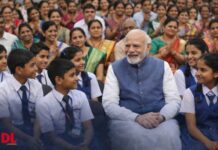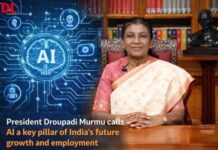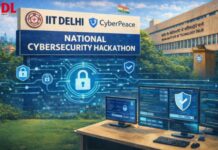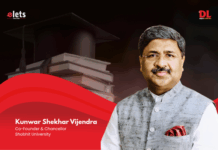|
Rita sheds some light on the Millennium System and its education delivery. |
Power School
Please tell us about the vision behind the Millennium School.
Millennium School is borne out of a revolutionising thought, which is to take leadership in the 21st century education. We have taken the best of Indian education and integrated it with the latest technology, for making 150 model schools catering to 21st century needs. We follow the Millennium Learning System – a child-centric philosophy developed after 14 years of research.
Can you elaborate on the Millennium Learning System, which is the guiding factor of the school?
Millennium Learning System is a philosophy which emerged after identifying the stresses in our education system and the solutions herein. When we went to the core of these stresses, we found that the curriculum wasn’t child-centric. The teaching was drab, making the child least interested in attending classes.
Moreover, children were stressed out due to exams. The Millennium Learning System is a philosophy which has come up with its own curriculum planning;
we have our own books which are concept-driven, globally mapped, and onforming to the CBSE pattern. After all, there is something good about the CBSE system, because of which our students are leading everywhere, be it IITs or Harvard! We also have our own teacher training programmes, which is roughly 160 hours, since delivery f this child-centric concept has to be done in an innovative way. Moreover, our R&D department prepares the content as well as lesson plans in advance. Another feature of this system is the ssessment. Our teachers are made to understand clearly the difference between xaminations and assessment. Examination is a burden but assessment is a
diagnostic remedial feedback to lead the child from one level to another. There is no unhealthy comparison in the classes, no marks or percentages. Is this applicable for all the classes?
Yes, it is applicable for all the classes. Digital Learning | Vol 4 Issu 12 December 2008 43 But we also need to look at thedevelopmental stage of a child. You cannot have the same recipe for all levels. So we call the nursery/KG, which is the preparatory classes, ‘Roots to Wings’. At Roots to Wings, we take a holistic view. For example, a child doesn’t look at the tree and understand that it is green because it has chlorophyll. He/she will look at it in a holistic manner, count the tree leaves, maybe pluck some flowers or leaves. ‘Roots to Wings’ ollows a different kind of curriculum, and classes 1-5 follow Millennium System I, classes6-8 follow Millennium System II and eventually class 9th onwards
we are affiliated to various boards like CBSE, IB, etc. Our children do so much of activity-based learning in the first two stages that by the time they are through with class 8, we expect them to be comfortable with the board pattern. We have to be part of the system, can not stay isolated. So the challenge for us is to
believe in the CBSE and yet see how we can come out with 15 years of happiness. After all, a happy child is always a happy adult! Many parents
have told us during interactions that their children want to come to school even on a Sunday! Today if a child tells me that he wants to be a pizza man, I will ask him to go ahead and make better pizzas than even Dominos.
Please tell us about the ongoing ICT initiatives in the school.
Technology in our school is integrated at different levels, one ofcourse is computer education which has become a must for all the schools. The second thing which is very imperative in our school is the Smart Class. Each and
every classroom have interactive boards, cameras etc. There is a software module (5-7 mins) of whatever content is taught as we feel children learn in three different ways: visual, auditory stimulation, and kinesthetics, ie, touch and feel. So our lesson plans cater to all the three stimuli, so that 100% learning takes place. Then from class three onwards, our children use the INTEL laptops. The lessons and assignments are transferred to each laptop through the router. Even the students send their feedback through it. We also do lot of project
work right though class 1, which requires lot of Internet activity. We are also building our own e-library. Our children also dont have to undergo extra coaching for Maths as we have the Maths Guru solution, which is an Educomp initiative. We also have a tie-up with IIT Chennai for one hour of interactive session on science and maths for class 9 onwards.
Is technology also used for carrying out capacity building?
Educomp’s R & D team, comprising around 1000 staff, is there to support us. Teacher training is very important, more so because teachers are a product of schooling in the 80s and 90s. Our teachers have to undergo 16 training modules
comprising concept based lessons. They are taught how to plan lessons and teach various concepts. We train them in carrying out 12 different learning strategies in the classroom. Computer training is also given to teachers where they are taught how to work on excel sheets, how to store or download nformation, etc. Earlier, you spoke about assessment of students. What about assessment for teachers? We do periodic observation of teachers, atleast thrice in a year. The idea is not to pinpoint the weaknesses, but discuss with them
various strategies to take them from one level to another, as is the case with students. So we have workshops for confidence building, feedbacks, iscussions, etc going on continously. We don’t believe in labeling either a student or eacher
What do you think of the publicprivate partnership in education? Honestly put, it is businessmen or industrialists who are into building hospitals and schools. But then the corporate is not there for money making alone. It is also an investment of thought or idea. Whenever a group of thinkers get
together, they bring out creativity and innovation.It is not driven by one man’s vision, but a synergy amongst various departments. What is the role of ICT in
education? Integration of IT in education has given us positive results. But at the same time, we need to be cautious and refrain from overuse. It should be used as a teaching aid and not replace a teacher or the book. As far as my children are concerned, IT just facilitates comprehension or gives them easy access to research or a project.








 Rita Kaul, Principal, Millennium School Noida, is a special educator and psychologist with 23 years of experience. She specialises in setting up innovative schools. She has been a recipient of many national awards for excellence in education, notable ones being Arch of Excellence (Education) Award 2001, Shiksha Shiromani Puruskar, and Spardhashree Award. Rita is a member of International Standards of Technical Education (ISTE, USA) for Delhi chapter. She has been the founder principal of The Heritage School , New Delhi and Senior School in-charge, Apeejay School, Faridabad. She has done extensive research in Value Education. Her two very significant publications include ‘Handbook of Value Education’ CBSE, 1998 and ‘School Ambience & Value Inculcation Through Curriculum’ – a handbook for teachers published in 2002 through the CBSE.
Rita Kaul, Principal, Millennium School Noida, is a special educator and psychologist with 23 years of experience. She specialises in setting up innovative schools. She has been a recipient of many national awards for excellence in education, notable ones being Arch of Excellence (Education) Award 2001, Shiksha Shiromani Puruskar, and Spardhashree Award. Rita is a member of International Standards of Technical Education (ISTE, USA) for Delhi chapter. She has been the founder principal of The Heritage School , New Delhi and Senior School in-charge, Apeejay School, Faridabad. She has done extensive research in Value Education. Her two very significant publications include ‘Handbook of Value Education’ CBSE, 1998 and ‘School Ambience & Value Inculcation Through Curriculum’ – a handbook for teachers published in 2002 through the CBSE.















